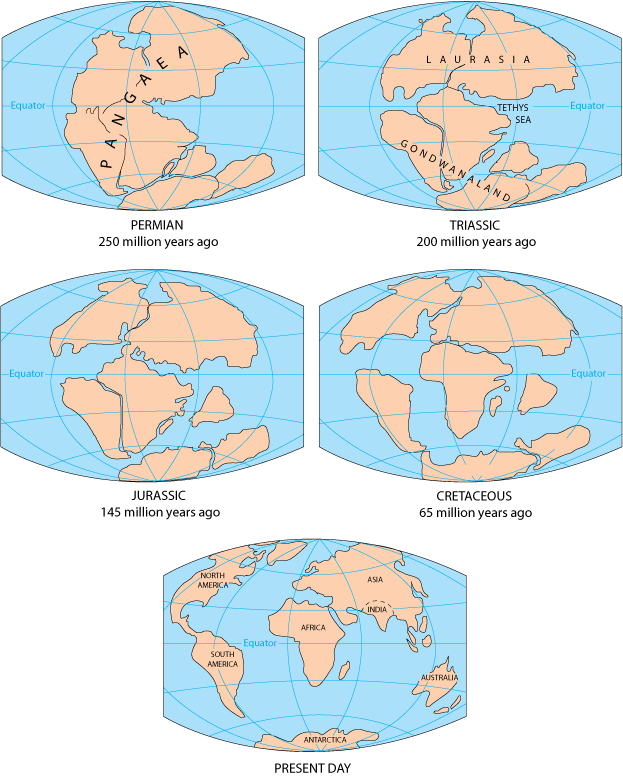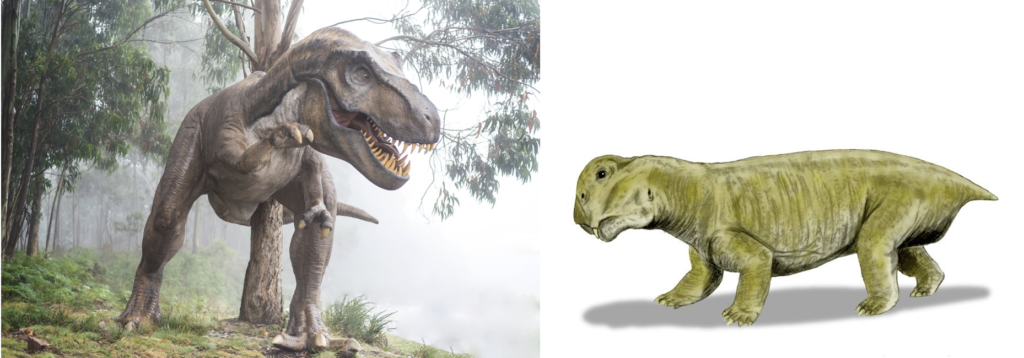Pangaea: Common Misconceptions
Nikola Kostadinovski & Damian Pang | 29 November 2021
Wild Imaginations
Pangaea often evokes wild imaginations of a circular ancient land littered with volcanoes and ancient ferns, where dinosaurs roamed. Much of this is not actually true. Here, we address some common misconceptions about Pangaea.
Shape
Pangaea is often depicted as roughly circular or rectangular, which is understandable as it depicts a simple unit. However, this is very inaccurate. Pangaea was curved, stretching somewhat in a north-south direction, but bent toward the east on both ends, like a chunky boomerang or a rough C-shape that encircled the Tethys Sea in the east1.

Dinosaurs
Pangaea often evokes vivid images of large dinosaurs. It is true that some dinosaurs roamed Pangea (mostly towards the end of its existence). But the dominance of dinosaurs and the appearance of the very large animals we often think of today only came after Pangaea started breaking up.2 For most of its time, Pangaea was dominated by synapsids, mammal-like reptiles, such as the small Lystrosaurus shown in the image below3. When dinosaurs died out, continents were much closer to the shape and location they are today than to Pangaea. In fact it was the breakup of this supercontinent that was crucial for the diversification and development of many dinosaur species4.

(left; image: Fuasto García-Menéndez) roamed the earth only after the breakup of Pangaea. Instead, the supercontinent was inhabited by mammal-like reptiles, like Lystrosaurus (right; image: Nobu Tamura).
Uniformity
Thinking of a single, large continent makes it easy to imagine a uniform landscape, climate, vegetation, and animal life. In reality, the opposite was true! The landscape had lot of variations, from vast lowlands, to hills, and very long and massive mountain chains5, 6. The coastal parts where more humid with lush vegetation while the centre—far away from any water—was arid and supported very little plant or animal life7. The large extent of the continent also meant a changing climate from the tropical centre to a mor temperate climate further south and north. These variations in climate across the supercontinent also resulted in very diverse plants and animals in each region8, 9. Weather patterns also changed during the year with evidence for super strong seasonal monsoon winds (called the Pangaean megamonsoon) that changed direction throughout the year10.
Other Supercontinents
Continental drift—the idea that continents move over very long time periods—was radical and revolutionary at its inception11. The concept of a nice uniform landmass slowly breaking up into the continent structures of today may seem appealing, but reality is far more complicated. Pangaea is not the only supercontinent in earth’s history. In fact the best evidence suggests that supercontinents form and break up in repeating cycles12. Identifying ancient continents is difficult but there is substantial evidence for at least two more besides Pangaea: Rodinia, and Columbia13. Depending on the criteria used to define what a supercontinent is, half a dozen more could be added starting with the ancient landmass of Ur14 to Pannotia15 (from which Gondwana split and later combined with Laurasia to form Pangaea16. What is clear is that Pangaea was neither the first nor only supercontinent.
Conclusion
Pangaea was a fascinating supercontinent that plays an important role in earth’s history. As the most recent and most well-known ancient landmass, a lot of myths have developed around this supercontinent. Many of these myths are inaccurate and some are outright wrong. Pangea was not circular and uniform, it was not teeming with large dinosaurs, and was not the only supercontinent. There is a lot we are still learning about this ancient continent and one way to move our understanding of it forward is to remove existing misconceptions.
1 Encyclopaedia Britannica (2021). Pangaea. Encyclopedia Britannica. URL: https://www.britannica.com/place/Pangaea
2 Davis, J. (n.d.). The Triassic Period: the rise of the dinosaurs. Natural History Museum. URL: https://www.nhm.ac.uk/discover/the-triassic-period-the-rise-of-the-dinosaurs.html
3 Davis, J. (n.d.). The Triassic Period: the rise of the dinosaurs. Natural History Museum. URL: https://www.nhm.ac.uk/discover/the-triassic-period-the-rise-of-the-dinosaurs.html
4 Button, D. J. (2017). Mass extinctions drove increased global faunal cosmopolitanism on the supercontinent Pangaea. Nature Communications, 8, 733. https://doi.org/10.1038/s41467-017-00827-7
5 Vai, G. B. (2003). Development of the palaeogeography of Pangaea from Late Carboniferous to Early Permian. Palaeogeography, Palaeoclimatology, Palaeoecology, 196(1-2), 125-155. https://doi.org/10.1016/S0031-0182(03)00316-X
6 Maritati, A. et al. (2020). Pangea rifting shaped the East Antarctic landscape. Tectonics, 39, e2020TC006180. https://doi.org/10.1029/2020TC006180
7 Parrish, J. T. (1993). Climate of the supercontinent Pangaea. Journal of Geology, 101(2), 215-233. https://doi.org/10.1086/648217
8 Davis, J. (n.d.). The Triassic Period: the rise of the dinosaurs. Natural History Museum. URL: https://www.nhm.ac.uk/discover/the-triassic-period-the-rise-of-the-dinosaurs.html
9 Parrish, J. T. (1993). Climate of the supercontinent Pangaea. Journal of Geology, 101(2), 215-233. https://doi.org/10.1086/648217
10 Soreghan, M. J., Soreghan, G. S. L., & Hamilton, M. A. (2002). Paleowinds inferred from detrital-zircon geochronology of upper Paleozoic loessite, western equatorial Pangaea. Geology, 30(8), 695–698. https://doi.org/10.1130/0091-7613(2002)030<0695:PIFDZG>2.0.CO;2
11 Romm, J. (1994). A new forerunner for continental drift. Nature, 367, 407–408. https://doi.org/10.1038/367407a0
12 Mitchell, R. N., et al. (2021). The supercontinent cycle. Nature Reviews Earth & Environment, 2, 358–374. https://doi.org/10.1038/s43017-021-00160-0
13 Mitchell, R. N., et al. (2021). The supercontinent cycle. Nature Reviews Earth & Environment, 2, 358–374. https://doi.org/10.1038/s43017-021-00160-0
14 Rogers, J. J. W., Santosh, M. (2003). Supercontinents in earth history. Gondwana Research, 6, 358-368. https://doi.org/10.1016/S1342-937X(05)70993-X
15 Nance, R. D., & Murphy, J. B. (2018). Supercontinents and the case for Pannotia. Geological Society, London, Special Publications, 470, 65-86. https://doi.org/10.1144/SP470.5
16 Rogers, J. J. W., & Santosh, M. (2004). Continents and supercontinents. Oxford, UK: Oxford University Press.